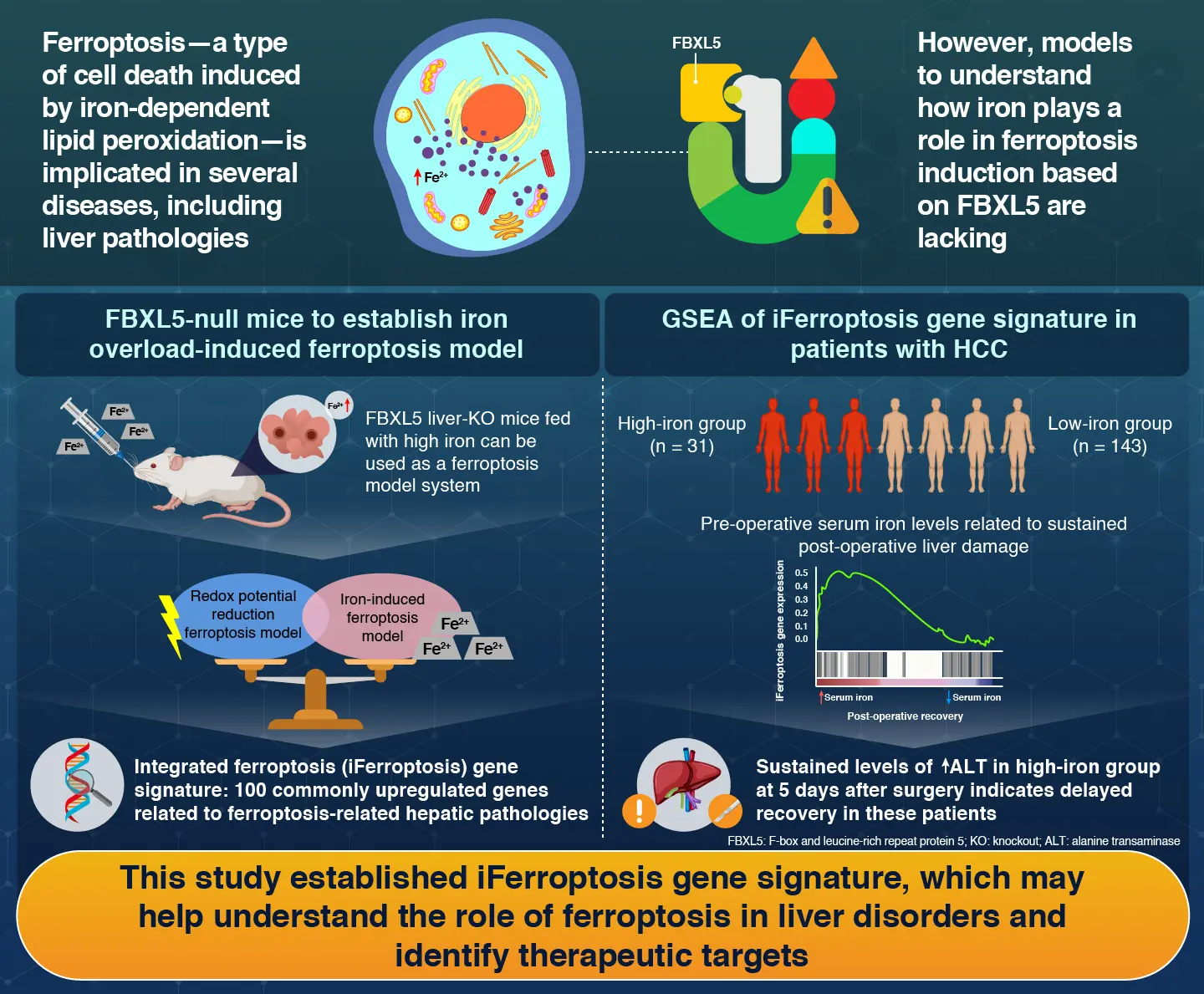Gene signature of hepatic ferroptosis reveals its pathogenic features
Transcriptome analysis of liver tissues derived from ferroptosis-induced mouse models identifies a gene signature indicative of hepatic ferroptosis
By establishing an iron overload-induced hepatic ferroptosis model, scientists from Japan have identified iFerroptosis–an integrated gene signature for ferroptosis. They evaluated the associated genes in both mice and human liver injury systems, validating the potential use of iFerroptosis as a biomarker for hepatic ferroptosis. By highlighting the role of ferroptosis in liver injuries, this study offers insights into unique therapeutic targets for ferroptosis.
Gene Signature of Hepatic Ferroptosis Revealed in Iron Overload-induced Mice Models

Matsumoto et al. (2025) | Hepatology Communications | 10.1097/HC9.0000000000000721
Excess intracellular iron triggers the production of highly reactive oxygen species, which rapidly oxidize phospholipids, causing cell damage and a form of death known as ferroptosis. Although ferroptosis has been associated with several diseases, recent evidence implicates it in liver pathologies like fibrosis, cirrhosis, liver cancer, and hepatic ischemia-reperfusion injuries (HIRI). Despite the direct impact of iron levels on ferroptosis, iron overload-induced ferroptosis models have not been established yet. A reliable ferroptosis model is crucial to identify specific gene expression patterns that may inform potential therapeutic interventions.
To address this gap, Professor Toshiro Moroishi from Institute of Science Tokyo (Science Tokyo), Japan, along with Dr. Takashi Matsumoto from Kumamoto University, Japan, led a collaborative team of researchers and established an iron overload-induced ferroptosis mouse model. They used this mouse model to uncover hepatic gene expression profiles of ferroptosis and validated this in both mouse models and human patients undergoing liver resections. These findings were published in Volume 9, Issue 6 of the journal Hepatology Communications on May 29, 2025.
Cellular levels of iron are regulated by the F-box and leucine-rich repeat protein 5 (FBXL5)–a substrate recognition component of a ubiquitin ligase complex–that helps degrade the iron regulatory proteins inside the cell. In this study, researchers developed the liver-specific FBXL5 knockout (FBXL5 liver-KO) mice and fed them with a high iron diet. "In the present study, we used this FBXL5 liver-KO to establish an iron overload-induced ferroptosis model and identify commonly regulated genes in the hepatic response to ferroptosis using a transcriptome-wide approach," explains Moroishi as the main objective of the team's study. Compared to control mice, FBXL5 liver-KO mice showed increased levels of liver damage along with high levels of lipid peroxidation in the liver, characteristic of ferroptosis. These findings confirmed that FBXL5 liver-KO mice were ideal hepatic ferroptosis animal models.
Transcriptomic comparison between liver tissues derived from control and FBXL5 liver-KO mice showed a marked difference in the expression profiles, suggesting that ferroptosis induces characteristic changes in the gene expression patterns. The gene expression profiles of this iron overload-induced ferroptosis model were also compared with those of a redox potential reduction-induced ferroptosis model to narrow down the hepatic gene signature indicative of ferroptosis. This revealed a set of 100 commonly upregulated genes in both models of ferroptosis, establishing an integrated ferroptosis gene signature for hepatic ferroptosis or iFerroptosis.
To understand the impact of ferroptosis on postoperative recovery in patients undergoing hepatic resections, the researchers examined preoperative serum iron levels in 174 patients. Patients with high preoperative serum iron levels showed significant enrichment of iFerroptosis gene signatures and had sustained postoperative liver damage compared to the low-iron group. This demonstrates that high-iron levels lead to hepatic ferroptosis, affecting prompt recoveries from hepatic surgeries.
This study identified a gene signature characteristic of hepatic ferroptosis using mice models of iron overload-induced ferroptosis. Not only did the research team validate this gene signature in human and mouse liver injury models, but they also highlighted how high serum iron levels may predict delayed postoperative recovery in patients with liver disorders.
Moroishi concludes by offering a potential application of their study, "Utilizing the iFerroptosis gene set may help to further understand ferroptosis-related hepatic disorders and offer insights into potential therapeutic strategies targeting ferroptosis to improve outcomes in patients with liver diseases."
Reference
- Authors:
- Takashi Matsumoto1,2, Akihiro Nita3, Yohei Kanamori1, Ayato Maeda1, Tomonomi Nita1, Noriko Yasuda-Yoshinari2,4, Kosuke Mima2, Hirohisa Okabe2, Katsunori Imai2, Hiromitsu Hayashi2, Yuta Matsuoka5, Katsuya Nagaoka6, Keiichi I. Nakayama7,8, Yuki Sugiura5, Yasuhito Tanaka6.9, Hideo Baba2,9, and Toshiro Moroishi1,3,9*
- Title:
- Integrated hepatic ferroptosis gene signature dictates pathogenic features of ferroptosis
- Journal:
- Hepatology Communications
- Affiliations:
- 1Department of Molecular and Medical Pharmacology, Faculty of Life Sciences, Kumamoto University, Japan
2Department of Gastroenterological Surgery, Graduate School of Medical Sciences, Kumamoto University, Japan
3Division of Cellular Dynamics, Medical Research Laboratory, Institute of Integrated Research, Institute of Science Tokyo, Japan
4R&D Laboratory for Innovative Biotherapeutics, Graduate School of Pharmaceutical Sciences, Kyushu University, Japan
5Center for Cancer Immunotherapy and Immunobiology, Kyoto University Graduate School of Medicine, Japan
6Department of Gastroenterology and Hepatology, Faculty of Life Sciences, Kumamoto University, Japan
7Anticancer Strategies Laboratory, Advanced Research Initiative, Institute of Integrated Research, Institute of Science Tokyo, Japan
8Department of Molecular and Cellular Biology, Medical Institute of Bioregulation, Kyushu University, Japan
9Center for Metabolic Regulation of Healthy Aging, Faculty of Life Sciences, Kumamoto University, Japan
Related articles
Further Information
Professor Toshiro Moroishi
Institute of Integrated Research, Institute of Science Tokyo
Contact
Public Relations Division, Institute of Science Tokyo
- Tel
- +81-3-5734-2975
- media@adm.isct.ac.jp